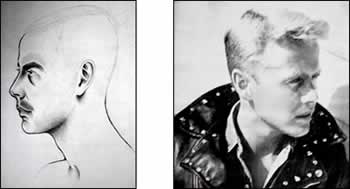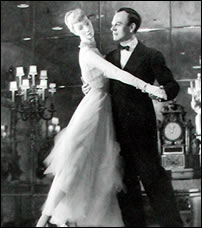Andy Warhol Pre-Pop
by Gary Comenas (2006)
page six
During 1955, the same year that Warhol got the I. Miller account, he also started doing windows for the Bonwit Teller department store, and continued to produce his promotional self-published portfolios.
A LA RECHERCHE DU SHOE PERDU (1955)
Warhol's next self-published book, A la Recherche du Shoe Perdu, featured many of the artist's shoe drawings. Again, it was a collaborative effort. Warhol did the pictures, Warhol's mother did the calligraphy and a poet named Ralph Pomeroy did the text, consisting of "shoe poems." Warhol had met Pomeroy through the artist, Dudley Huppler.

Dudley Huppler
in Flair magazine (1950)
(Photo: Melton-Pippin)
Warhol had probably been introduced to Huppler by Otto Fenn who photographed Huppler in the autumn of 1951. (1) Like Warhol, Huppler sold some of his drawings at Serendipity 3. (2) He also did windows for Bonwit Teller in 1955 - the same year as Warhol. Just as Warhol gave Easter eggs to art directors as gifts, Huppler gave eggs to friends as gifts. According to a 1950 article in Flair magazine, Huppler liked eggs for their "symmetry" and "hidden meanings." (3) By 1954, Warhol and Huppler were corresponding. In approximately 1956, Warhol gave Huppler a shoe drawing with the inscription, "To Dudley from Andy Morningstar." In approximately 1960, Huppler did a drawing of a shoe, naming it "Rabbit in Andy Warhol Shoe." (4)
Huppler could be less kind to Warhol behind his back. According to Warhol's friend, Ted Carey, "Dudley didn't like Andy very much." (5) In an undated letter sent to Karl Priebe, probably in 1954 (6), Huppler wrote on the back of a page from Warhol's portfolio, Love is a pink Cake, that "These are by Warthole, as Carol [Blanchard] calls him. Andy Warhol. He's dumb and nice - with bulb nose. Awful young and callow." (7) Later, during the early sixties, Huppler wrote to Priebe, 'In Time [magazine], it sez in first note on society doings that Wartnose Warhole is one of desirable men every hostess has to have one of... So, quite a comment on current society, if he's a plum." (8)
However, on September 24, 1954 Huppler wrote the following to the composer Lee Hoiby. Huppler wrote the libretto for Hoiby's 1954 opera, Something New for the Zoo.
Dudley Huppler (from a letter to Lee Hoiby, 24 September 1954):
"If I don't explain Andy very clearly, it's because he is all a delightful atmosphere that doesn't take shape. He writes letters of just one phrase or indeed sometimes nothing at all, but every time I get one something jumps in me - I feel, This is a uniqueness, a quintessentialness - a real invention in personality. Never saw him but talked on the phone, when he offered me enough drawings to paper a room, and then when I said No, a cat - my choice of 17 Siamese! . . . . . Yesterday came a huge drawing of 5 young boys -- so dewy, yet no insistence, all like an extended scratch but not a false move in it. He decorated the dust-jacket of the first New Dir. Firbank, all wrong, but I don't hold that against him if it couldn't be, or have been Karl it might as well have been anybody and all wrong too; that follows. Anyway, he's almost what keeps me going out here - something to tack the thoughts to. . ." (SHU)
In the spring of 1955, Huppler met Ralph Pomeroy at the artists' retreat, Yaddo, in Saratoga Springs, New York. Pomeroy had received a grant to work on his poetry at Yaddo. He had previously published a book of poems in 1948 titled Poetry. On May 6, 1955 Huppler sent a postcard to Warhol from Yaddo, telling him that he had met "a new phenomenally bright writer, Ralph Pomeroy, that I'll draw so you can see." (9)

L: Ralph Pomeroy the Poet (1955) by Dudley Huppler
(Inscribed "Ralph Pomeroy/DH/at Yaddo")
R: Photograph of Ralph Pomeroy (ca. 1961) by M. Quercia
After Warhol and Pomeroy met, they decided to collaborate on A la Recherche du Shoe Perdu. The title of the book reflected Pomeroy's nebulous connection to Marcel Proust's similarly titled book, A la Recherche du Temps Perdu. Pomeroy's surname derived from Normandy. The original spelling of it, "de la Pommeraie" was mentioned in Proust's book by M. Brichot. Pomeroy emphasized this Proustian connection in the short biography of himself that appeared in a book of his poetry that was published in 1961 in San Francisco, where he lived after leaving in New York. In San Francisco he taught Comparative Literature at San Francisco University and, during the 1970s, wrote two books - one on the joys of ice-cream titled Ice Cream Connection: All You'd Love to Know about Ice Cream (1975) and another on the joys of breakfast titled A Connoisseur's Companion to Breakfast (1977).
In the summer of 1955 Warhol's career as a commercial artist took a new turn when Gene Moore hired him to provide artwork for the windows of the Bonwit Teller department store. Moore had arrived in New York in 1935, hoping to become a fine artist, and had ended up a window dresser. One of the jobs Moore took to support himself in New York was making paper mache flowers for the Bob Smith Display Company. When one of Smith's customers, Jim Buckley, was made the display director of I. Miller Shoes in approximately 1937, he hired Moore to be his assistant. By the following year, Moore was also doing window dressing for Bergdorf Goodman's and Delman's department stores. In 1945 he was appointed the display director for Bonwit Teller. (10) Moore often modeled his mannequins on Hollywood stars like Vivien Leigh and Audrey Hepburn, and was responsible for introducing the belly button on mannequins. He would later recall, "I longed for nipples, but I'm not responsible for them. Someone else came up with nipples... The belly button is mine, though... the addition of a properly placed navel helped me center garments on mannequins." (11) According to Moore, "People recognized the mannequins in my windows. Some of the mannequins even acquired fans... I admit I once kissed one of my mannequins, but I won't tell which. I just wanted to see what it would be like. It was like kissing a desk." (12)

Gene Moore dancing with one
of
his mannequins at Bonwit Teller
(Photographer unknown)
Gene Moore:
"Andy Warhol was reasonably well-known by the time he came to see me, although he was still being called Raggedy Andy, not because his work was sloppy, but because of his appearance. He'd had success with book-jacket designs for such publishers as New Directions and with his drawings and paintings for I. Miller shoe ads - and I knew I. Miller - but stories about his mishaps were making the rounds. When he'd zipped open his portfolio to show his work to the art director at Harper's Bazaar, a cockroach had crawled out. Poor boy, that Raggedy Andy. But Harper's had given him assignments. He won awards for his work, for his 'commercial' art, and he never pretended a difference between what he did to survive and what he called his art. To his credit, I think it was all the same to him. He was a very busy young man. I used Warhol's art in several of my perfume windows at Bonwit's. In July 1955, just before my work began at Tiffany's, I made some wooden fences, and he covered them with graffiti for a series of windows. They were fun, full of a childish playfulness." (13)
The cockroach story became part of Warhol's legend. It was repeated in The Philosophy of Andy Warhol (From A to B and Back Again). (14) However, according to Philip Pearlstein, the incident had actually happened to him, not to Warhol. (15)
Warhol wasn't the only artist working for Moore. He was also using Robert Rauschenberg and Jasper Johns, who were window dressing under the combined pseudonym, Matson Jones. According to Moore, James Rosenquist, Andy Warhol, Robert Rauschenberg and Jasper Johns all worked with him during the same period. (16) Rauschenberg and Johns continued to do windows for him when, in July 1956, Moore also started doing windows for Tiffany's in addition to his continued involvement with Bonwit Teller.
Gene Moore:
"Robert Rauschenberg and Jasper Johns called themselves artists but were unknown when they first came to see me. Rauschenberg came first. He'd been to Black Mountain College in South Carolina and heard about me, and came up to my office at Bonwit's... During the period Rauschenberg was contributing to the displays at Bonwit's he met Jasper Johns. They became friends and shared a loft downtown... The first showings of John's paintings were in exhibitions I organized at Bonwit's... in 1957 I showed Flag on Orange Field in a Bonwit's window." (17)